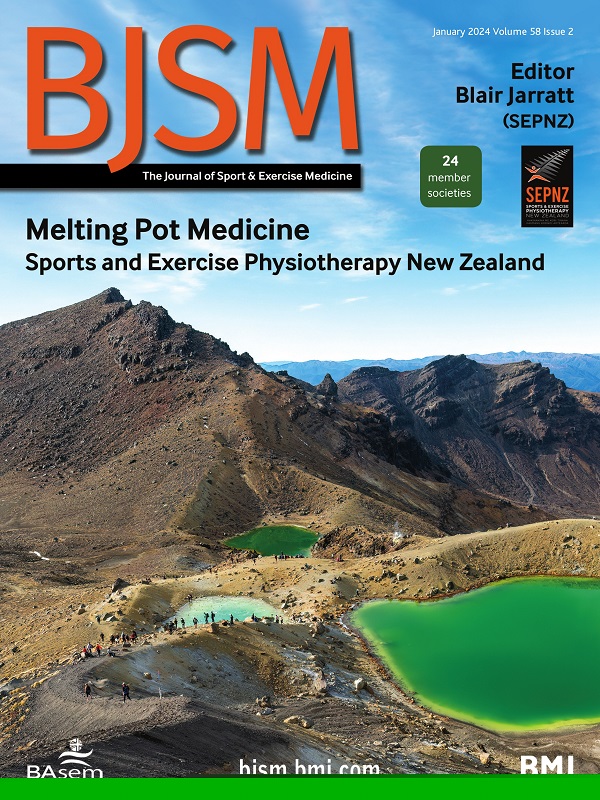我们是否应该对退役的接触性运动运动员进行颈椎脊髓退行性病变早期症状筛查?
IF 11.6
1区 医学
Q1 SPORT SCIENCES
引用次数: 0
摘要
退行性颈椎脊髓病(DCM)是一种上运动神经元病变征象的临床症状,通过先进的影像学检查证实颈椎脊髓受到压迫。1 DCM 的常见症状包括上下肢力量和协调性丧失、步态功能障碍以及膀胱和肠道功能障碍。DCM 是脊髓损伤的主要原因2 ,如果不及时治疗,可能会导致灾难性症状和终身残疾。虽然 DCM 在普通人群中的平均患病率较低,约为 2.22%(95% CI 0.44% 至 2.68%),但特定人群的患病风险更高,如老年人(年龄大于 79 岁)的平均患病率为 4.16%(95% CI 0.82% 至 5.03%)。5 虽然确切的机理尚不清楚,但接触性运动运动员反复承受机械负荷和颈椎损伤的增加有可能是导致脊柱早期退化的原因之一。5 本评论探讨了对接触性运动运动员进行 DCM 筛查以促进早期诊断和干预的潜在益处。与其他脊髓损伤不同,DCM 不需要创伤性事件,而且发病隐匿,因此诊断和检测...本文章由计算机程序翻译,如有差异,请以英文原文为准。
Should we screen retired contact sport athletes for early signs of degenerative cervical myelopathy?
Degenerative cervical myelopathy (DCM) is a clinical condition of upper motor neuron lesion signs, that is confirmed with advanced imaging demonstrating compression of the spinal cord in the cervical spine.1 Common symptoms of DCM include loss of upper and lower limb strength and coordination, gait dysfunction, and bladder and bowel dysfunction.2 The difference between DCM and other sports-related spinal cord injuries is that DCM results from spinal cord compression due to gradual degenerative changes, making detection more difficult. DCM is a leading cause of spinal cord injury2 and can result in catastrophic symptoms and lifelong disability if left untreated.2 While the mean prevalence of DCM is low in the general population at around 2.22% (95% CI 0.44% to 2.68%), specific populations are at greater risk, such as older adults (>79 years of age) who have a mean prevalence of 4.16% (95% CI 0.82% to 5.03%).3 People from Asia-Pacific and African regions are also reported to have an increased prevalence of DCM and/or cervical stenosis.4 A recent review of the risk factors for the development of DCM reported that long-term participation in contact sports may be associated with increased rates of early spinal degeneration as well as spinal cord injury secondary to cervical spinal stenosis.5 While the exact mechanism remains unclear, it is possible that the combination of repeated mechanical loading and increased prevalence of cervical injuries in contact sport athletes is a cause of early spinal degeneration. In particular, premature cervical spondylosis can lead to DCM in some contact sport athletes.5 This commentary explores the potential benefits of screening contact sport athletes for DCM to facilitate early diagnosis and intervention. Unlike other spinal cord injuries, DCM does not require a traumatic event and can have an insidious onset, making diagnosis and detection …
求助全文
通过发布文献求助,成功后即可免费获取论文全文。
去求助
来源期刊
CiteScore
27.10
自引率
4.90%
发文量
217
审稿时长
3-8 weeks
期刊介绍:
The British Journal of Sports Medicine (BJSM) is a dynamic platform that presents groundbreaking research, thought-provoking reviews, and meaningful discussions on sport and exercise medicine. Our focus encompasses various clinically-relevant aspects such as physiotherapy, physical therapy, and rehabilitation. With an aim to foster innovation, education, and knowledge translation, we strive to bridge the gap between research and practical implementation in the field. Our multi-media approach, including web, print, video, and audio resources, along with our active presence on social media, connects a global community of healthcare professionals dedicated to treating active individuals.

 求助内容:
求助内容: 应助结果提醒方式:
应助结果提醒方式:


